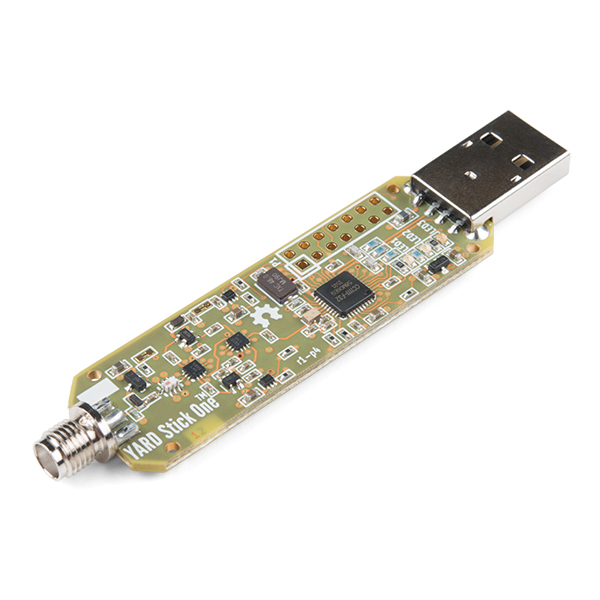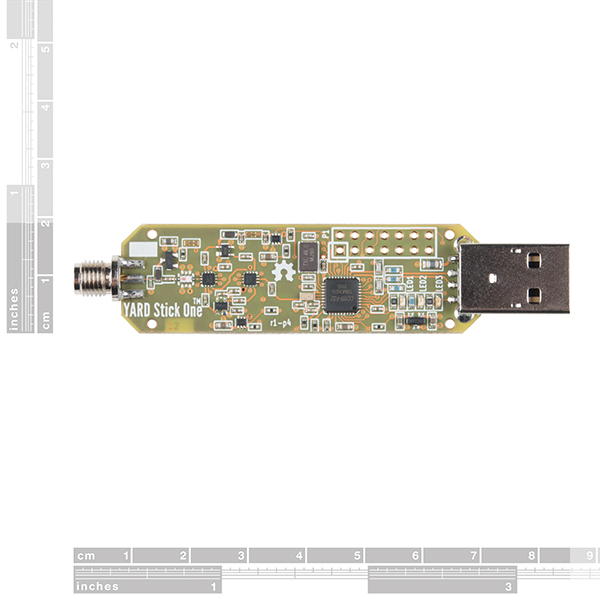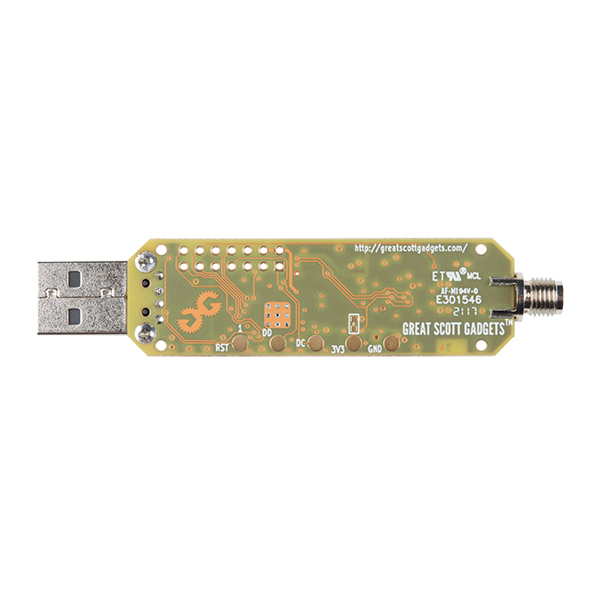×
SparkFun will be closed on Tuesday, December 24th, and Wednesday, December 25th, in observance of the Christmas holiday. Any orders qualifying for same day shipping placed after 2:00 p.m. (MST) on Monday, December 23rd, will be processed on Thursday, December 26th, when we return to regular business hours. Wishing you a safe and happy holiday from all of us at SparkFun!
Please note - we will not be available for Local Pick up orders from December 24th-December 27th. If you place an order for Local Pick-Up we will have those ready on Monday, December 30th.
YARD Stick One - USB Wireless Transceiver
The YARD Stick One (Yet Another Radio Dongle) is a palm-sized, low-speed USB wireless transceiver (similar to a Software Defined Radio or SDR) from Great Scott Gadgets that can transmit or receive digital wireless signals at frequencies below 1GHz. It uses the same radio circuit as the popular IM-Me. The radio functions that are possible by customizing IM-Me firmware are now at your fingertips when you attach YARD Stick One to a computer via USB.
With official operating frequencies of 300-348MHz, 391-464MHz, and 782-928MHz, the YARD Stick One is a half-duplex SDR that can transmit and receive under ASK, OOK, GFSK, 2-FSK, 4-FSK, MSK at data rates up to 500kb per second. The YARD Stick One is equipped with a simple SMA connector for external antennas, an antenna port power control for compatibility with antenna port accessories, GIMME-compatible programming test points, as well as a GoodFET-compatible expansion and programming header. Luckily, the YARD Stick One features strong RF performance across the entire operating frequency range with a low pass filter for elimination of harmonics when operating in the 800MHz and 900MHz bands.
The YARD Stick One also comes with RfCat firmware installed. RfCat allows you to control the wireless transceiver from an interactive Python shell or your own program running on your computer. YARD Stick One also has CC Bootloader installed, so you can upgrade RFCat or install your own firmware without any additional programming hardware.
Note: Please keep in mind that an antenna is not included with the YARD Stick One. If you are looking for a good starter antenna, the ANT500 is recommended.
- Half-Duplex Transmit and Receive
- Official Operating Frequencies: 300-348MHz, 391-464MHz, and 782-928MHz
- Unofficial Operating Frequencies: 281-361MHz, 378-481MHz, and 749-962MHz (As found by Great Scott Gadgets)
- Modulations: ASK, OOK, GFSK, 2-FSK, 4-FSK, MSK
- Data Rates up to 500kbps
- Full-Speed USB 2.0
- SMA Female Antenna Connector (50 ohms)
- Software-Controlled Antenna Port Power (Max 50mA @ 3.3V)
- Low Pass Filter for Elimination of Harmonics When Operating in the 800MHz and 900MHz Bands
- GoodFET-Compatible Expansion and Programming Header
- GIMME-Compatible Programming Test Points
- YARD Stick One Wiki
- YARD Stick One GitHub
- RfCat GitHub (Courtesy of atlas)
- CC-Bootloader
- Introduction Page
- Product Page
YARD Stick One - USB Wireless Transceiver Product Help and Resources
Core Skill: Programming
If a board needs code or communicates somehow, you're going to need to know how to program or interface with it. The programming skill is all about communication and code.
Skill Level: Competent - The toolchain for programming is a bit more complex and will examples may not be explicitly provided for you. You will be required to have a fundamental knowledge of programming and be required to provide your own code. You may need to modify existing libraries or code to work with your specific hardware. Sensor and hardware interfaces will be SPI or I2C.
See all skill levels
Core Skill: Electrical Prototyping
If it requires power, you need to know how much, what all the pins do, and how to hook it up. You may need to reference datasheets, schematics, and know the ins and outs of electronics.
Skill Level: Noob - You don't need to reference a datasheet, but you will need to know basic power requirements.
See all skill levels
Comments
Looking for answers to technical questions?
We welcome your comments and suggestions below. However, if you are looking for solutions to technical questions please see our Technical Assistance page.
Customer Reviews
No reviews yet.




